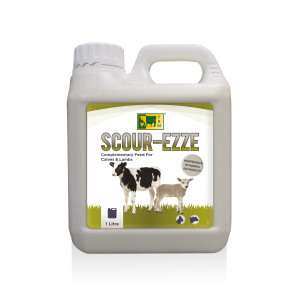Treatment of Calf Scour

Practical Advice for the Treatment of Calf Scour
Being a most common health problem, neonatal scouring/ diarrhoea is a leading cause of mortality (up to 40% within first six weeks of life) in beef and dairy calves. (Ref: Teagasc, Calf Rearing Manual, Section 6) With a maximum susceptibility of the issue within the first two weeks of birth, an increased discharge of manure and fluids from the animal is seen. This is primarily due to altered gut function with extensive loss of water and electrolyte ions like sodium, potassium and chloride along with a shift in the natural gut microbiome.
Causes of scour
Scours could be classified as infectious (caused by bacteria, virus and parasites) and non-infectious. Though most of the infection-related scouring require a veterinarian intervention with drug treatments, non-infectious causes are majorly due to nutritional deficiencies, poor management of animals and even stress related abnormalities. Table 1 below, further classifies the non-infectious causes.
Table 1: Non-infectious causes of scour.
|
Nutritional |
Dietary change, overfeeding, poor quality milk replacers, indigestion, inadequate intake and low quality of colostrum, poor quality of water, lust or wet pastures, improper dry matter intake, toxins, allergies |
|
Management |
Poor sanitation, overcrowding |
|
Stress |
Weather extremes, handling, shipping/ transportation |
Symptoms of scour
Though most commonly, scouring is recognised by increased frequency and quantity of fluid loss than normal, a few other symptoms include,
- Bright yellow or white faeces.
- Sunken eyes, tented skin when lifted indicating dehydration
- Loss of appetite
- Fatigue and weight loss
Prebiotics and scour
Prebiotics are nondigestible dietary ingredients, usually oligosaccharides, which are selectively fermented by the gut microbes, providing beneficial changes in composition and activity of the gut. Simply, they work by acting as ‘food’ for the target microbes, stimulating their growth, especially in the lower gut. Their effectiveness very well corelates to their acid stability, better absorption and hydrolysis by gastrointestinal enzymes. (Ref: Prebiotics: The New Feed Supplement for Dairy Calf, A Singh, et al., 2017)
Scouring disturbs the natural microbiota of the gastrointestinal track, which otherwise function in maintaining a good health along with strong immunity. Further, the population of pathogenic microbes could increase during scouring. Prebiotics increase the population of good microbes giving no space for the bad microbes to grow in the rumen. The beneficial prebiotics also trigger a molecular pattern to boost the immune system.
Electrolytes and scour
Electrolyte ions, particularly the sodium (Na), Potassium (K), and Chloride (Cl), are very important in maintaining normal metabolic functions and homeostasis of the body. These include maintaining the correct plasma osmolarity and physiologic pH. (Ref: Treatment of Calf Diarrhea: Oral Fluid Therapy, Geof W. Smith, 2009)
Once scouring, an animal becomes rapidly dehydrated, acidotic, and low in essential electrolytes in the body. A huge amount of water is also lost along with the excretion of electrolytes. Hence, it becomes essential to rehydrate them with an effective balance of water and electrolytes.
Treatment of scour:
The swift management and treatment of the animal, particularly young animals critical in ensuring a positive outcome.
Although specific treatments are available for scour depending on the causal pathogen, the following steps should be taken in all cases:
- Isolation of scouring animal in a clean, dry and warm pen
- Rehydration therapy with water and electrolytes solutions
- Supplemental treatment using prebiotics, oral clay suspension to adsorb endotoxins.
- Milk feeding
- Antibiotics for severe infections
Prevention of scour
Whether an animal stays healthy or gets scour is determined by the overall health status of the animal prior to the onset of scour and the level of infection to which it is exposed.
- Ensure adequate colostrum in the first few hours after birth.
- Carefully plan shed designs to avoid overcrowding.
- Avoid mixing different ages as younger animals will be more susceptible.
- Minimise stresses associated with husbandry practices
- Maintain strict hygiene by cleaning and sterilising frequently
- Prevent the build-up of faecal contamination around feed and water troughs.
- Develop a routine milk feeding program with as few people involved as possible.
- Respond quickly to symptoms of scour; isolate sick calves and address the cause.
Scour-ezze ingredients and their role
- Kaolinitic clay – adsorbs gut endotoxins
- Fructooligosaccharide – acts as a prebiotic
- Sodium Chloride, Potassium Chloride, Magnesium Sulphate, Calcium Gluconate – Electrolyte replenisher
- Pectin – gastrointestinal protectant
- Glycine – aids the absorption of electrolytes and water.

